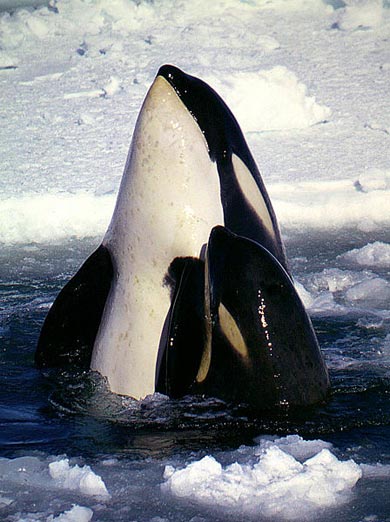The killer whale (Orcinus orca), commonly referred to as the orca, is a toothed whale belonging to the oceanic dolphin family. Killer whales are found in all oceans, from the frigid Arctic and Antarctic regions to tropical seas.
Killer whales are regarded as apex predator, lacking natural predators and preying on even large sharks. [List of apex predators]
Wild killer whales are not considered a threat to humans.
Killer whales distinctively bear a black back, white chest and sides, and a white patch above and behind the eye. Calves are born with a yellowish or orange tint, which fades to white.
Males and females have different patterns of black and white skin in the genital area.
There are three to five types of killer whales that may be distinct enough to be considered different races, subspecies, or possibly even species. The IUCN reported in 2008, “The taxonomy of this genus is clearly in need of review, and it is likely that O. orca will be split into a number of different species or at least subspecies over the next few years.”
• Type A looks like a “typical” killer whale, a large, black and white form with a medium-sized white eye patch, living in open water and feeding mostly on minke whales.
• Type B is smaller than Type A. It has a large white eye patch. Most of the dark parts of its body are medium gray instead of black, although it has a dark gray patch called a “dorsal cape” stretching back from its forehead to just behind its dorsal fin. The white areas are stained slightly yellow. It feeds mostly on seals.
• Type C is the smallest type and lives in larger groups than the others. Its eye patch is distinctively slanted forwards, rather than parallel to the body axis. Like Type B, it is primarily white and medium gray, with a dark gray dorsal cape and yellow-tinged patches. Its only observed prey is the Antarctic Cod.
• Type D was identified based on photographs of a 1955 mass stranding in New Zealand and six at-sea sightings since 2004. Immediately recognizable by its extremely small white eye patch, shorter than usual dorsal fin that curves back, and bulbous head (similar to a pilot whale). Its geographic range appears to be circumglobal in subantarctic waters between latitudes 40°S and 60°S. And although nothing is known about the Type D diet, it is suspected to include fish because groups have been photographed around longline vessels where they reportedly depredate Patagonian toothfish (Dissostichus eleginoides).
Types B and C live close to the ice pack, and diatoms (algae) in these waters may be responsible for the yellowish coloring of both types. Mitochondrial DNA sequences support the theory that these are separate species that have recently diverged.
{ Wikipedia | Continue reading }























